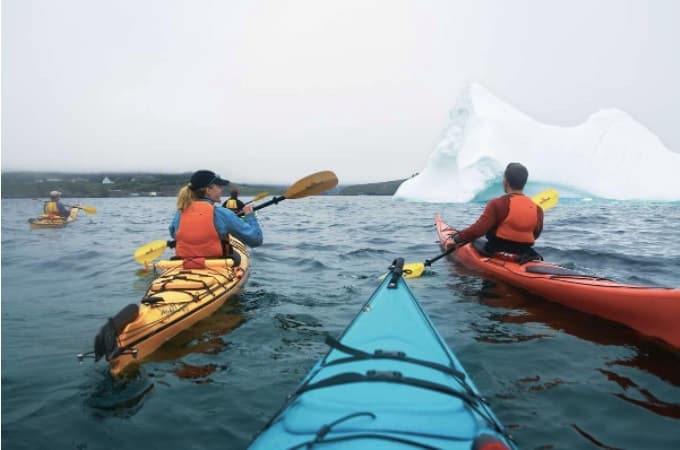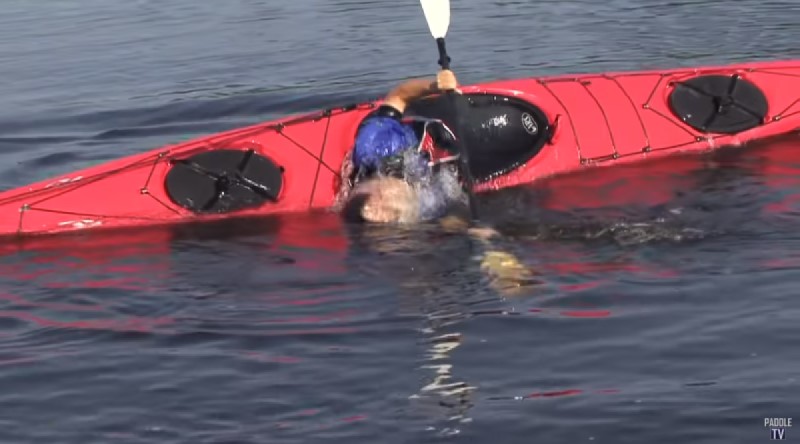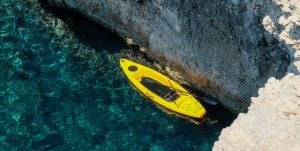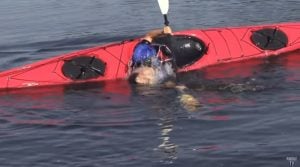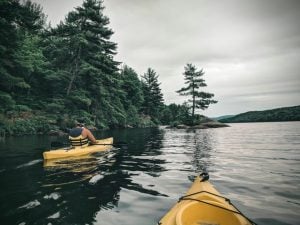The Short Answer:
Learning how to roll a kayak is essential to maintaining safety and convenience while you’re on the water. Regardless of the position, you’re in underwater when you capsize, you can learn how to successfully roll your kayak back over by having the correct setup position, by using a solid hip-snap maneuver and by maintaining the correct power position throughout the rolling technique.
—
Regardless of whether you’re an experienced kayaker or you’ve only been kayaking a few times before, it’s almost inevitable that you’ll eventually capsize in your kayak, flipping the boat and you underwater. This can happen for many different reasons, whether the water is simply not in your favor or you’ve lost balance while in your boat.
But capsizing can not only be prevented, but you can also learn how to roll your kayak back over, without getting out and swimming to shore. Learning how to roll your boat is one of the most helpful and convenient kayaking tips that you can engage with, saving you time and ensuring a safer kayaking trip for you and your buddies.
But how exactly do you roll a kayak? And what types of do I need to practice rolling a kayak? Here is a guide that can help you to further understand what’s involved with rolling a kayak. You’ll find the most helpful information about what to do in an instance where you’ve capsized and how to regain control of the boat easily. You’ll even learn the different types of paddle rolls and techniques involved. To help you jumpstart the learning process, here is a YouTube video that can introduce you to the act of rolling a kayak. After watching the video, this guide can provide you with more in-depth information and advice.
Table of Contents
Ideal Scenarios to Learn
Before actually flipping your kayak over and trying to learn how to roll it yourself, you may find it helpful and more productive to learn from an instructor, with other people and in calm water to ensure the most safety.
Learn from an Instructor
Learning how to roll a kayak from an instructor is one of the most helpful and effective ways to learn the technique because you are actually doing it. Not only does having someone else there to teach you allow you to learn the techniques better, but it’s also safer because you then have someone to assist in case something goes wrong. Learning from an instructor is effective because they are highly trained professionals that have most likely been rolling kayaks for years, and they have probably been in the same position that you’re in.
More specifically, instructors have gone through the process of learning how to roll a kayak, so they can provide you with the most helpful advice and learning techniques. Not only that, but learning from an instructor is a more hands-on learning experience that can make you have more long-lasting results, ensuring that you’re performing each of the steps correctly.
You can typically find a kayak instructor online, whether it’s from a kayaking school website or a swimming school. Regardless, you’ll benefit from using an instructor because of their experience, techniques and skill, hands-on learning experience as well as their ability to teach you many other techniques as well.
Learn in Calm, Warm Water Near Shore
Other than having a trained professional there with you, you may also find it helpful to learn how to roll in calm waters. Even though you’re more likely to capsize your kayak in rough bodies of water, it’s important that you learn all of the techniques required in order to successfully tip your kayak the right way. So by rolling it in calm waters, you can focus more on learning the techniques than what the water is like.
I recommend that you learn how to roll your kayak in a swimming pool and with a smaller tippy kayak, since pool water is clean, safe and probably more comfortable for you. It’s also more clear to see through, so you can easily follow the paddle blades as they travel through the water.
But if you don’t have access to a swimming pool or your kayak is too big to fit inside of the pool, then I’d recommend that you practice in a shallow, calm and warmer body of water. Whether it’s a lake, ocean, or a pond, calmer and warmer waters can help to ensure that you’re more comfortable, allowing you to focus on your techniques rather than the conditions of the water.
What You Need to Learn to Roll
A Narrow “Tippy” Kayak
To ensure that you can learn how to effectively roll a kayak, you’ll need a kayak that’s more narrow than wide. This is because a narrow kayak is easier to tip over than a wider one. Wider kayaks provide you with more stability, so you’re not only less likely to tip over in them, but they can be difficult to manage while you’re learning how to roll it.
Narrow Touring kayaks are easier to roll because they have a smaller base width, making it more susceptible to capsizing and, in turn, easier to learn how to roll in. You can find a narrow, tippy kayak from practically any outdoor store. And you even have the ability to purchase one from various retailers online. Just keep in mind that you may have to pay extra for shipping, given its larger size than a normal shipping package.
Goggles
Aside from a kayak that’s more narrow and easier to flip, you may also want to consider purchasing goggles. They’ll help you learn how to roll a kayak easier because you can be able to open your eyes easily and more comfortably underwater while you’re wearing them. You should be able to open your eyes underwater because you’ll need to see the positions of the kayak paddle that you’re holding.
When you wear goggles, you can remain comfortable while still watching the paddle blade. And watching the blade is recommended because it can help to encourage your body to move throughout the water in the right manner. It can also keep your body in the power position, which is required for rolling a kayak. Lastly, wearing goggles is a safety precaution, since it keeps debris and other harmful substances out of your eyes while you’re set up under the water’s surface.
Spray Skirt
Having a spray skirt is helpful for practicing to roll your kayak because it can prevent too much water from coming into your kayak and making it more difficult to flip back over. The spray skirt is essentially an attachment that you can assemble onto the cockpit of the kayak, and it goes around your waist. By having this, you can keep your body within the kayak and encourage the motions of your hips to control the whole kayak more easily. You don’t necessarily need one, but having one can make the process much easier.
A Decent Paddle
Lastly, you’ll want to make sure that you have a high-quality paddle with you to learn how to roll your kayak. A large part of rolling a kayak involves the performance and capabilities of the paddle since you’ll be using the paddle to push off of the water and regain the upwards position. Higher quality paddles will essentially have a wider and more detailed blade, and they will also usually have a retractable assembly that gives you the ability to change its length.
Different Types of Paddle Rolls
There are two main types of paddle rolls that you can learn, each having their own pros and cons. Considering that they’re largely similar aside from the catchphrases, it all depends on personal preference as to which one will work best for your needs. Rolling your kayak involves three main steps: the setup, the catch and the recovery.
C to C Roll
Classified as the easier roll to learn, the C to C roll is the most common and requires less time and skill to practice. To conduct the C to C roll, you’ll want to first set up your kayak. To do so, you’ll need to place your paddle next to your kayak in the water so that it’s parallel with the side. You’ll also want the power blade in the front part of the kayak, since this will be the controller later on.
After you’ve placed the paddle alongside your boat, you should then duck your head and curl your upper body down towards the paddle in the water. This will turn the kayak over so that you’re underwater. While doing this, you should keep in mind that your body should be kept as close to the surface of the water as possible to ensure that you have a speedy recovery and more control throughout.
Additionally, you should keep your dominant hand on the front part of the paddle, since the front portion of the paddle will essentially be doing all of the work during the process. Now that you’re in the setup position, you’ll now be moving to step two, which is the catch phase. During this, you should swing your paddle 90-degrees from the kayak with your control hand, and you should do so while maintaining a close distance between the water’s surface and while you’re in the power position.
Once your paddle is on top of the water, you’ll then want to catch the water and push it downwards, thus creating support for you to snap your hips and position yourself above water. It’s important that you keep the power position throughout the entire procedure, which is essentially keeping your hands in front of your body, even if you have to twist your upper body some. This is required in order to maintain control and power over the water, the kayak and your body.
Sweep Roll
To conduct the sweep roll, you’ll essentially have the same setup position as you do with the C to C roll. So you should start with your body underwater and the kayak upside down with the paddle 90 degrees from the kayak. The catch phase in the sweep roll differs from the C to C roll because instead of keeping your non-dominant arm against the side of the kayak to create a pivot, you’ll be keeping it bent and in a wider stance.
More specifically, you’ll want to apply downward pressure from the beginning as you’re sweeping the paddle 90 degrees from the kayak. Additionally, you should sweep the paddle in a wide position while keeping your arm away from the kayak and close to the water’s surface. Your non-dominant arm should be kept closer to your body. Similarly to the C to C roll, you should maintain the power position throughout this process and keep your arms relatively fixed while you’re twisting your torso. This motion is essentially what causes the paddle to conduct a sweeping motion.
Which is Easiest for Beginners?
Regardless of the type of experience you have, both types of rolls are more suitable for beginners in general. Even more, many professional kayak trainers actually refer to these rolls as learning rolls, since they involve a step-by-step process that you can follow. On the other hand and as you gain more experience, you’ll be engaging in rolls that involve more instinctual behavior.
More specifically, professionals and more experienced kayakers are capable of rolling their kayak from any type of position, just as long as their head and body are on the surface of the water and their paddle is in a position that’s capable of supporting enough water to push off of. That being said, both of these rolls are suitable for beginners, but given the catch phases of each type, the C to C roll is usually the easiest to learn.
Although the sweep roll requires less to set up and positions your paddle closer to the surface of the water, it is more difficult to learn because of its combining two steps into one single motion. Because of that, beginners tend to have a more difficult time trying to learn how to roll their kayak by following steps that require more technique and skill.
Recovery
The recovery is named the last step of the rolling process, and it ultimately refers to the landing position your body takes when you finish the process and rest above the water’s surface. This step can differ from person to person, since some individuals prefer to swing their upper body more backward, while others prefer a more frontward position. Both seem to work fine in re-positioning your body back on top of the kayak on the water, so it’s really up to your personal preference.
During the recovery process, you’ll want to remember that your head should be the last part of your body that comes out of the water and is placed in the resting position. If you lift your head too soon, then you risk putting too much weight onto the water that you’re supposed to be pushing on with the power blade. In other words, if you lift with your head before your hips, then you won’t regain control over the boat and will remain underwater.
A tip for remembering this is to watch the active blade while it’s underwater and you’re conducting the steps. By watching the blade, you can keep your head down and encourage your body to conduct the torso rotation needed for a successful hip snap and lift.
Final Thoughts
Overall, learning how to roll your kayak is a process that takes time, patience and skill. With that being said, you don’t want to rush trying to learn how to flip your kayak back over after you capsize. This will only encourage frustration, and forcing the process can lessen the probability that you’ll remember how to repeat the steps in the future.
By taking your time and ensuring that you complete all steps effectively, you can more successfully learn and remember how to roll your kayak. And with the right kind of gear, instructor and water conditions, you’ll be flipping your kayak back over in no time at all. I hope that you’ve enjoyed this tutorial and have gained some insight on what to do in the case of capsizing. If you’ve found it helpful at all, you’re encouraged to share for your friends to see. And if you have any additional advice, please leave a comment down below.

